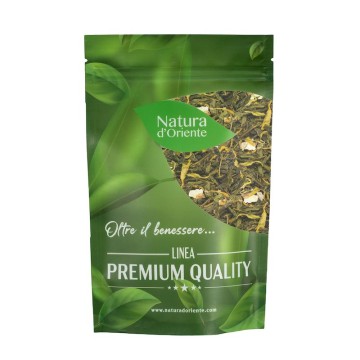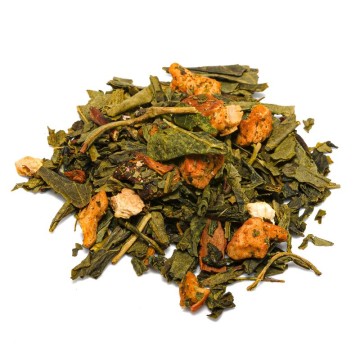This infusion offers the fresh and fragrant notes of orange, combining them with the exotic and spicy aroma of ginger. The fruity and light taste fades towards the pungent notes of ginger, with a flavor that warms and envelops the palate in the cold months - useful in case of colds. The drink becomes thirst-quenching if served cold in summer, delicious at any time of the day.
Properties and benefits
This green tea can be a good source of antioxidants and detoxifying benefits. Furthermore, rich in nutrients, green tea with ginger and orange becomes a delicacy to drink and beneficial for the body. The best known virtues are detoxifying and diuretic, which can help eliminate excess fluids and promote slimming diets. Proper circulation also comes by counteracting water retention, and also supporting an anti-cellulite diet with green tea. The benefits of orange ginger tea include nutrient intake that aids digestive well-being.
They help relieve the symptoms of digestive disorders such as stomach pain, indigestion, heartburn or bloating. Plus, it can help ease the symptoms of nausea. Ginger was once considered a natural anti-inflammatory, and today we know that it contains the compound gingerol, which helps support the body's natural response to irritation, especially in the digestive phase. Furthermore, orange peel contains pectin, a soluble fiber useful against digestive problems such as diarrhea, vomiting and constipation. Still at the level of food assimilation, ginger is also known for the properties that help, together with green tea, in diets that stimulate the metabolism to eliminate body fat.
This tea can give energy through all substances contained between ginger, orange and green tea – with its theine / caffeine. The orange peels are inserted into the tea precisely to donate the compounds that help the body. They contain potassium, an element beneficial to the heart, muscles and nervous system. Furthermore, orange enhances the antioxidant effects of green tea, counteracting cellular aging and the damage that oxidation can cause to our cells. In fact, green tea contains a catechin called epigallocatechin-3-gallate (EGCG), a powerful natural antioxidant that helps prevent cell damage.
The ingredients rich in vitamin C, from tea to orange peel and calendula, promote the well-being of the immune system. Another factor that makes this drink beneficial, in fact, is given by the useful properties against colds and runny nose. You can drink a cup of orange-ginger tea even if you often suffer from cough, helping to loosen phlegm and relax the respiratory system. Orange peel is known to relieve respiratory congestion, and ginger relaxes inflamed nasal passages. This tea gives warmth to the body and, at the same time, leaves a feeling of freshness.
Origins and History of cultivation
Chinese small-leaf tea Camellia sinensis was first created from wild plants, by infusing the leaves, and then cultivated – probably for the first time in the mountains of the Chinese province Sichuan or, according to other scholars, from Yunnan. In China, the history of steeping the leaves in water dates back to over 2700 BC, and the first tea garden, attributed to Wu Li Zhen, is thought to be around 2000 years old. Sencha green tea is also deeply rooted in Japanese life, but was introduced from China via a religious mission, by Buddhist monks in the 8th century AD. Initially, tea leaves were ground in Japan.
Over time, steamed tea, green tea as we know it, became popular. It is a method of preparation that, over time, has also become increasingly popular in Japan, and today Sencha is the main green tea. The methods of oxidation of green tea lead to an evolution of flavor and appearance, and the Japanese method of steam cooking alternates with the Chinese method of pan cooking (born in the 12th century). Green tea has become a widely consumed beverage in all Asian countries, including India.
From the 19th century onwards, tea also spread to western countries, thanks to English trade from China: the supply of tea became plentiful and less expensive, allowing everyone to enjoy this infusion. Probably native to Southeast Asia, the ginger plant has been known for thousands of years for the use of its root (rhizome) in cooking. The botanical name of the spice zingiber comes from the Sanskrit name singabera. This is because the upo use in India, as in China, has been known since ancient times. In the 1st century BC. traders exported ginger to the Mediterranean region, and it spread until the Middle Ages as a rare and beneficial spice. It arrived via the Spanish on American soil, soon after the conquest.
Today it is spread all over the world, appreciated as a spice with a slightly pungent taste. The root is usually dried and ground to flavor sauces, bread, sweets, drinks, curries. The orange plant is native to India or the tropical regions of Asia (especially the Malay archipelago). Together with other citrus species, it has been cultivated since ancient times by man, and has spread to the east coast of Africa and the Mediterranean. Propagated as a plant also thanks to the Roman conquests and the Arab trade routes, it was introduced in America after its discovery, even if at the time of Columbus orange trees were already widespread in the Canary Islands. Today, oranges are grown mainly in Italy, Spain, the Caribbean islands, the United States, subtropical and tropical America, Morocco, Australia and South Africa.
Plant and flowers
Camellia sinensis, also called Thea sinensis, is an evergreen shrub of the Theaceae family. It is a plant native to China according to some, and gives tea through the infusion of the leaves, one of the most consumed beverages in the world. It reproduced naturally and evolved very well as a crop through many natural combinations. Camellia sinensis has three subspecies, Assam, China and Cambodia, versatile in terms of yield, quality, adaptation to different terrains and geographical locations (it grows up to over 2,000 meters in height). Shows green leaves, hand-picked in several spring crops, yellow or white flowers. It is grown in full sun or in the shade, with care to obtain different qualities of tea. Ginger (Zingiber officinale) is a perennial herbaceous plant of the Zingiberaceae family.
Its underground rhizome, with aromatic and nutritional properties, is used as a spice, aroma, food and medicine in herbal medicine. The ginger stems grow to about 1 meter tall, with elongated leaves, yellow-green and purple flowers. Ginger is propagated by stem cuttings, it has been cultivated in this way and without seed for centuries. The harvest takes place by lifting the rhizomes from the ground, which are found in an irregular, branched or palmate shape. They are cleaned and left to dry in the sun. Orange peel is obtained from the dried outer part of the pericarp of Citrus aurantium fruit. One of several species of shrub in the genus Citrus, in the family Rutaceae. The plant grows well in clayey soils, and starts bearing fruit after 5-6 years. When the fruits are just ripe, they are harvested by hand. The skins are treated to extract the oil, or dried and stored for later use. Other economically important species and varieties of oranges that can donate orange peel are the sweet or common orange (Citrus ×sinensis) or the blood orange.
Nutritional values of Orange Ginger Green Tea
Green tea has components such as antioxidant catechins, tannins / bitter substances, and flavonoids. They mainly include phenols, in addition to theanines, saponins, as well as essential oils, amino acids. Gives the body theine / caffeine, as a central nervous system stimulant. It makes the antioxidant vitamin C and other vitamins of Group B available. It gives other useful substances such as minerals (fluorine, zinc, manganese, copper, selenium). Ginger is rich in chemical constituents such as phenolic compounds, terpenes, polysaccharides, lipids, acids.
Health benefits are attributed primarily to the phenolic compounds gingerols and shogaols; an essential component is zingiberene and the pungent principle is given by zingerone. Orange peel contains compounds such as limonene, linalool, myrcene, as well as pectin, and excellent doses of vitamin C.
How to prepare orange ginger green tea
The infusion of orange peel and ginger tea is obtained by placing in a cup (250 ml), about 3-5 grams of this green tea. Water at a temperature of 80 °C. Leave to infuse for 2 to 3 minutes, before drinking the green tea infusion.
Orange ginger green tea: side effects and contraindications
Green tea, overall, is considered one of the safest beverages to consume. However, it could lead to several side effects, although many are rare, related to the caffeine or tannin components. For individuals sensitive to taAmong the elements, it is good to always consume green tea in moderation, avoiding excessive doses.
Excessive consumption can cause symptoms such as headache, agitation, irregular heartbeat, difficulty falling asleep, diarrhea, hypertension. Excessive doses may disturb the digestive system through intestinal irritation (especially on an empty stomach).
Also, some of the common side effects if excessive amounts of ginger tea are consumed are: heartburn, intestinal gas, bloating, and nausea. Green tea should be taken with caution by those suffering from anemia, high blood pressure and pathological heart conditions. Caution is advised when taking green tea during pregnancy and breastfeeding.









 No reward points for this product.
No reward points for this product.



![green tea roasted almond [Natura d'Oriente]](https://www.naturadoriente.com/3366-home_default/green-tea-with-roasted-almonds.jpg)


![Green Tea Choui Fong Tea [Natura d'Oriente]](https://www.naturadoriente.com/3379-home_default/green-tea-choui-fong-tea.jpg)






![Green Tea Sencha Kombucha [Natura d'Oriente]](https://www.naturadoriente.com/3380-home_default/-green-tea-sencha-kombucha-.jpg)

